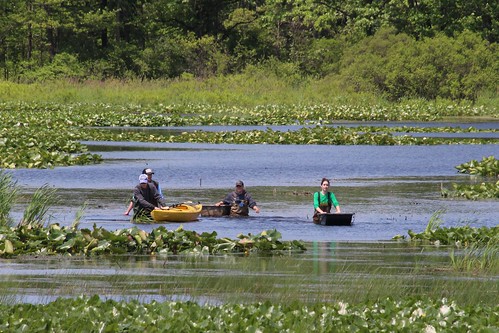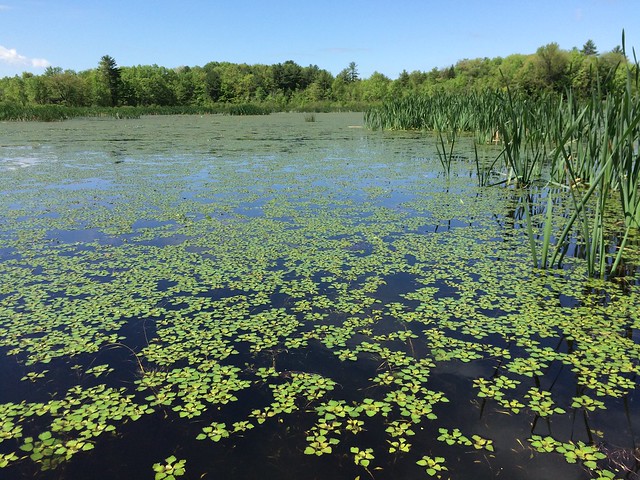The water slipped up to my waist as I wandered out into the pond. The muddy bottom sucked at my toes, requiring a slower, more deliberate pace. Others around me were scattered about, moving in the same ways, slowly and carefully, while scanning the top of the water for the distinct, bright green profile of Water Chestnut.
This invasive plant showed up at Audubon over ten years ago. It reminds me of a bright green floating pancake made up of arrow-shaped leaves. These floating leaves connect with a twine-like stem to a spiky, black seed sunk into the mud. The goal of myself and the volunteers around me is to pull out the leaves gently enough that the stem does not break and the spiky seed comes out with it.
I pull the plants out one at a time, placing the leaves and seeds in a jet sled that I tow behind me. This sled is tiny compared to what I’ve towed in the past. When the plant was first identified, we went out in a john boat that we filled to the brim. Later, a canoe was towed out and filled every half an hour or so. The Water Chestnut dilemma seemed insurmountable.
In fact, it wouldn’t be hard to find volunteers who remember those early days of Water Chestnut pulling. They remember tons of work for little gain. Audubon made the decision to use herbicides to kill the plant back. This happened for two years in a row and allowed the plant to come under enough control that pulling the plant by hand could help.
Every year since, Audubon has hired people to help pull Water Chestnut out of the pond with the aid of volunteers. In fact, there will be a volunteer pulling party on Saturday, June 6 at 8:00 a.m. to kick off the Water Chestnut pulling season by getting as many plants as possible while they are still small and easy to manage. You can find more information on ACNC’s website under the programs and events tab.

Water Chestnut is small and harmless looking around Memorial Day. Each plant is the size of a half dollar and takes up little space. By July, those harmless looking half dollar sized plants will be the size of dinner plants and that leads to big problems.
The leaves cover every available surface of the pond, blocking sunlight from plants lower in the water and preventing others from growing. As they die in the fall, rotting Water Chestnut leaves can literally suck all the air out of the pond, suffocating fish and other animals in the water.
At one point, Audubon’s Big Pond (so named because it is a large 40-acre pond) was completely covered with Water Chestnut from one side to the other. It was impossible to control and impossible to get rid of in that huge amount, which is why the drastic action was taken to spray the pond.
That pond is now, admittedly, different. It’s always been shallow, but now cattails and reeds have grown up. This has created shelter and nesting areas for birds that didn’t used to nest there, such as Common Gallinules, Soras, and other birds with names as awkward as the way they move. These birds showed up with the cattails and weeds, walking across the Water Chestnut from one patch of tall cover to the next.
It is easy to look at Water Chestnut as an Audubon problem. Audubon has had Water Chestnut issues and promoted its removal for years now, but it is truly a community problem. The seeds travel on waterfowl and kayaks and float downstream, bringing new incidents of Water Chestnut where they land.
Not only is Water Chestnut bad for the ecology of the pond, it is bad for the people nearby. The sharp seeds make swimming unpalatable and walking barefoot in the water dangerous. The floating plants tangle up boat propellers, paddles, and fishing lines.

ACNC received funding from the Chautauqua Lake and Watershed Alliance to assist landowners within the Chautauqua Lake Watershed with Water Chestnut removal during the summer of 2020. ACNC Water Chestnut removal assistance is available in June and July, but it is limited based on the availability of staff and funding. If you discover Water Chestnut on your property, and you would like to request assistance with removal, please visit auduboncnc.org/invasive-species-management for more information. All Water Chestnut outbreaks should also be reported through IMAP invasives or through the Western New York Parnership for Regional Invasive Species Management (WNYPRISM) at wnyprism.org.
Water Chestnut is an invasive species that has the potential to cause huge problems in the region, both for wildlife and for recreation. If you see it, please report it to WNYPRISM, remove it, or call Audubon if you need help knowing what to do next. Help stop the spread of Water Chestnut and keep our waterways clear.
Audubon Community Nature Center builds and nurtures connections between people and nature. ACNC is located just east of Route 62 between Warren and Jamestown. The trails are still open from dawn to dusk as is Liberty, the Bald Eagle. Though the Nature Center is currently closed, including restrooms, due to COVID-19 restrictions, drive-thru sales are available from the Blue Heron Gift Shop. More information can be found online at auduboncnc.org or by calling (716) 569-2345.
Jeff Tome is a Nature Educator at ACNC.


Recent Comments